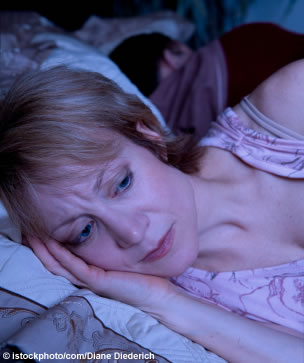 Sleep disruption is the most common and severe symptom reported by middle-aged women when their periods change and they start moving into the menopause, according to a study in the April issue of the UK-based Journal of Clinical Nursing.
Sleep disruption is the most common and severe symptom reported by middle-aged women when their periods change and they start moving into the menopause, according to a study in the April issue of the UK-based Journal of Clinical Nursing.
Researchers at the University of Arizona College of Nursing, USA, spoke to 110 women entering the menopause – when periods can become lighter or heavier and occur at longer or shorter intervals. Their average age was 49 and they had all experienced their last menstrual period in the last three years.
On average, they reported suffering from seven of the ten most common menopause symptoms.
95% suffered from sleep difficulties, 92% from forgetfulness, 87% from irritability, 85% from night sweats and 91% from hot flashes or flushes.
The other symptoms reported were: mood swings (75%), depression (71%), day sweats (66%), vaginal dryness (55%) and irregular bleeding (35%).
Women taking part in the study were also asked to rate the severity of ten menopause symptoms on a scale of zero to four, where zero was no symptoms and four was extreme. The average severity score was 20.8 out of a possible 40.
Difficulty sleeping was the most severe symptom, scoring an average of 2.90 out of four, followed by night sweats (2.58), irritability (2.56), forgetfulness (2.42), hot flashes or flushes (2.41) and mood swings (2.12).
Women reported that they were less affected by day sweats (1.88), depression (1.73), vaginal dryness (1.45) and irregular bleeding (0.82).
“We also talked to the women about how frequently they experienced symptoms” says lead researcher and associate professor Dr Judith A Berg. “Women who reported problems with day sweats and hot flashes or flushes experienced an average of six a day and women who had problems with night sweats averaged just under three a night.”
The average time since the women’s last menstrual period (LMP) was five months and the cut off point for the study was 36 months since the last period. Women were included in the study if they had a minimum severity score of at least 12 out of 40 when they were asked to rate the ten key symptoms on a scale of zero to four.
Women who had health problems like diabetes or a history of breast or uterine cancer were excluded, as were women who were on certain types of medication, like hormone treatment or tranquilisers.
The researchers found that some menopausal symptoms changed in frequency as women moved further into the menopause. But sleep disturbance was a notable exception, remaining constant regardless of when a woman had had her LMP.
For example women who had had their LMP in the last two months experienced an average of 3.4 hot flashes or flushes a day and this more than doubled to 7.60 in women who had had their LMP in the last three to 11 months. By 12 months plus the level had fallen to 6.83.
The pattern was the same for day sweats, starting at 3.50 a day and rising to 5.97 before falling to 5.17.
However, night sweats rose consistently during this time, starting at 1.86, then rising to 2.67 and 3.25.
“This contradicts earlier research which sought to link sleep difficulties with night sweats and problems like hot flashes or flushes” stressed Dr Berg. “Although the severity of these problems changed as the women progressed through the early stage of the menopause, the sleep difficulties the women reported remained fairly constant.”
The study also showed that, with the exception of sleep difficulties, the most common symptoms reported by the women were not necessarily the ones that they said were the most severe.
“For example, forgetfulness was the second most commonly reported symptom, but when it came to severity it only rated seventh out of the 10 symptoms studied” says Dr Berg.
“And night sweats were the fourth most common symptom, but women rated them second when it came to severity.
“These findings underline the importance of talking to women about the severity of symptoms and the distress they cause as well as how frequently they occur.”
The researchers note that a number of previous studies have identified hot flashes or flushes as the biggest problem for menopausal women.
“Our study looked at women who were relatively young and the time lapse since their last period was shorter than in a number of previous studies” explains Dr Berg. “It is known that hot flashes or flushes increase as the menopause progresses and emerging data suggests that other symptoms are more severe in the earlier stages.”
A woman is said to have reached the menopause when she has not had a period for a year. During this phase, known as the perimenopause, the hormonal and biological changes associated with the menopause begin and many women experience both physical and emotional symptoms.
“What our study clearly shows is that women who are entering the menopause find sleep difficulties a frequent and distressing problem and that this problem was consistently reported by women in the sample, regardless of when they had had their last period” concludes Dr Berg.
Source: Wiley Blackwell via Eureka
